21.5-inch iMac (Late 2013) Review: Iris Pro Driving an Accurate Display
by Anand Lal Shimpi on October 7, 2013 3:28 AM ESTThe Display
When it was first announced, I shrugged off the 21.5-inch iMac model. At the time I was using a 27-inch Thunderbolt Display and couldn’t see myself using anything smaller, or lower resolution. With the new 27-inch iMac looking a lot like last year’s model with evolutionary upgrades on the internals, I was obviously drawn to the new 21.5-inch system because of its use of Intel’s Iris Pro 5200 graphics so I ended up with the first < 3MP desktop display I’d used since the release of the first 30-inch 2560 x 1600 panels years ago.
Given how much time I spend on notebook displays these days, now was as good a time as any to go back to a 1080p desktop display. While I’d prefer something with an insanely higher resolution, it’s still too early for a 21.5-inch 4K panel (or a 27-inch 5K panel), which Apple would likely move to in order to bring Retina displays to its desktops.
There are two reasons why you’d opt for the 21.5-inch iMac vs. the larger one: cost and size. At a bare minimum you’re looking at a $500 price difference between the 21.5 and 27-inch iMacs, which is pretty substantial to begin with. The size argument is just as easy to understand. The 27-inch iMac occupies a considerable amount of space on my desk, and I’ve come to realize that not everyone likes to be surrounded by a sea of desks. Either way there’s clearly a market for a computer this size, with this sort of a resolution. So how does the display fare?
In short: it’s nearly perfect.
Brian and I were comparing notes on the two reviews we’re working on at the same time. He sent me some CIE diagrams showing me color accuracy for the displays he’s testing, I responded with this:

21.5-inch iMac (Late 2013) Saturations
Those boxes show what’s expected, the circles inside of them show what’s delivered by the display. The 21.5-inch iMac is spot on, out of the box, without any calibration required. Brian’s response:
WOW
is that out of the box?
The iMac’s display does extremely well in all of our tests, always turning in a delta E of less than 2. It’s just incredible. I'm borrowing the graphs below from our tablet bench data, but I've tossed in the 2013 MacBook Air as a reference point.

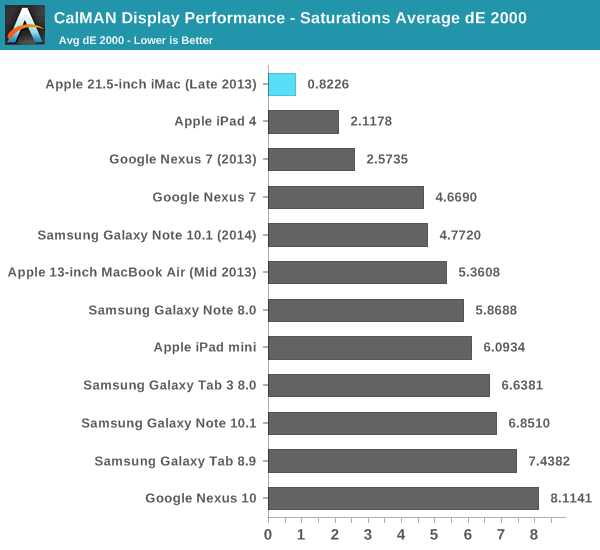
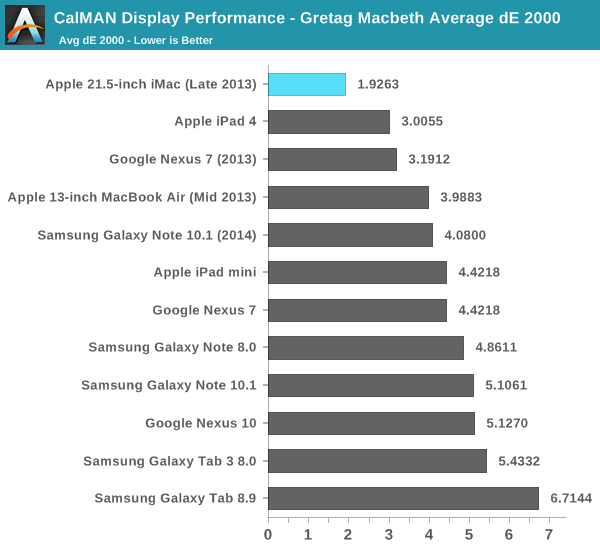

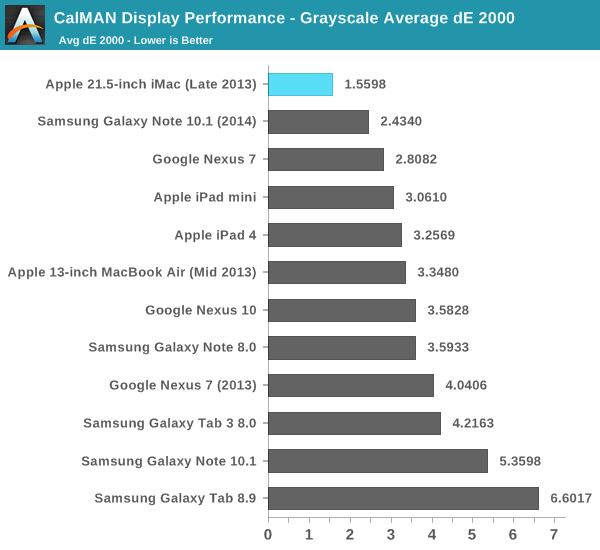
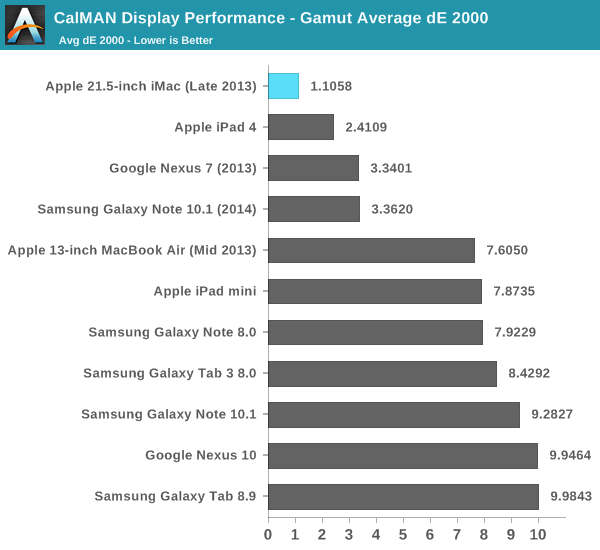

Although I doubt Apple’s intended audience for the entry-level 21.5-inch iMac are imaging professionals, they could very well use the system and be perfectly happy with it. Literally all that’s missing is a 2x resolution model, but my guess is it’ll be another year before we see that.
I have to point out that Apple does source its display panels from multiple providers (typically 2 or 3), not to mention panel variance within a lot. I don’t anticipate finding many panels better than the one in my review sample, but it’s always possible that there will be worse examples in the market. I haven’t seen huge variance in color accuracy from Apple panels, so I think it’s a pretty safe bet that what you’re going to get with any new iMac is going to be awesome.



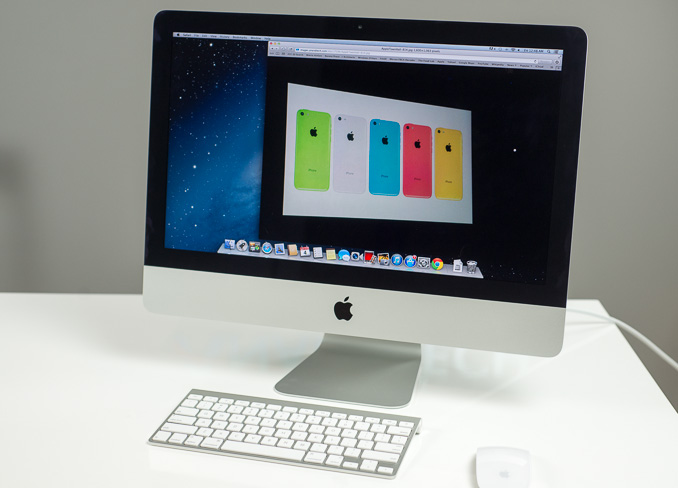











127 Comments
View All Comments
elian123 - Monday, October 7, 2013 - link
Anand, could you perhaps indicate when you would expect higher-res iMac displays (as well as pc displays in general, not only all-in-ones)?solipsism - Monday, October 7, 2013 - link
Before that happens Apple will likely need to get their stand-alone Apple display "high-res". I don't expect it to go 2x like avery other one of their display; instead I would suspect it to be 4K, which is exactly 1.5x over the current 27" display size. Note that Apple mentioned 4K many times when previewing the Mac Pro.Also, the most common size for quality 4K panels appears to be 31.5" so I would't be surprised to see it move to that size. When the iMacs are to get updated I think each would then most likely use a slightly larger display panel.
mavere - Monday, October 7, 2013 - link
~75% of the stock desktop wallpapers in OSX 10.9 are at 5120x2880.It's probably the biggest nudge-nudge-wink-wink Apple has ever given for unannounced products.
name99 - Monday, October 7, 2013 - link
Why does Apple have to go to exactly 4K? We all understand the point, and the value, of going to 2x resolution. The only value in going to exactly 4K is cheaper screens (but cheaper screens means crappy lousy looking screens, so Apple doesn't care).jasonelmore - Monday, October 7, 2013 - link
4k is 16:9 ratio, to do a 16:10 right, they would have to do 5krepoman27 - Monday, October 7, 2013 - link
iMacs have been 16:9 since 2009, and 3840x2400 (4K 16:10) panels have been produced in the past and work just fine.repoman27 - Monday, October 7, 2013 - link
Apple is pretty locked in to the current screen sizes and 16:9 aspect ratio by the ID, and I can only imagine they will stick with the status quo for at least one more generation in order to recoup some of their obviously considerable design costs there.Since Apple sells at best a couple million iMacs of each form factor in a year’s time, they kinda have to source panels for which there are other interested customers—we’re not even close to iPhone or iPad numbers here. Thus I’d reckon we’ll see whatever panels they intend to use in future generations in the wild before those updates happen. As solipsism points out, the speculation that there will be a new ATD with a 31.5”, 3840x2160 panel released alongside the new Mac Pro makes total sense because other vendors are already shipping similar displays.
I actually made a chart to illustrate why a Retina iMac was unlikely anytime soon: http://i.imgur.com/CfYO008.png
I listed the size and resolution of previous LCD iMacs, as well as possible higher resolutions at 21.5” and 27”. Configurations that truly qualify as "Retina" are highlighted in green, and it looks as though pixel doubling will be Apple’s strategy when they make that move. I also highlighted configurations that require two DP 1.1a links or a DP 1.2 link in yellow, and those that demand four DP 1.1a links or two DP 1.2 links in red for both standard CVT and CVT with reduced blanking. Considering Apple has yet to ship any display that requires more than a single DP 1.1a link, and all of the Retina options at 27" are in the red is probably reason alone that such a device doesn't exist yet.
I also included the ASUS PQ321Q 31.5" 3840x2160 display, and the Retina MacBook Pros as points of comparison to illustrate the pricing issues that Retina iMacs would face. While there are affordable GPU options that could drive these displays and still maintain a reasonable degree of UI smoothness, the panels themselves either don't exist or would be prohibitively expensive for an iMac.
name99 - Monday, October 7, 2013 - link
OR what you chart tells us is that these devices will be early adopters of the mythical (but on its way) DisplayPort 1.3?Isn't it obvious that part of the slew of technologies to arrive when 4K hits the mainstream (as opposed to its current "we expect you to pay handsomely for something that is painful to use" phase will be an updated DisplayPort spec?
repoman27 - Monday, October 7, 2013 - link
Unlike HDMI 1.4, DisplayPort 1.2 can handle 4K just fine. I'd imagine DP 1.3 should take us to 8K.What baffles me is that every Mac Apple has shipped thus far with Thunderbolt and either a discrete GPU or Haswell has been DP 1.2 capable, but the ports are limited to DP 1.1a by the Thunderbolt controller. So even though Intel is supposedly shipping Redwood Ridge which has a DP 1.2 redriver, and Falcon Ridge which fully supports DP 1.2, we seem to be getting three generations of Macs where only the Mac Pros can actually output a DP 1.2 signal.
Furthermore, I don't know of any panels out there that actually support eDP HBR2 signaling (introduced in the eDP 1.2 specification in May 2010, clarified in eDP 1.3 in February 2011, and still going strong in eDP 1.4 as of January this year). The current crop of 4K displays appear to be driven by converting a DisplayPort 1.2 HBR2 signal that uses MST to treat the display as 2 separate regions into a ridiculously wide 8 channel LVDS signal. Basically, for now, driving a display at more than 2880x1800 seems to require multiple outputs from the GPU.
And to answer your question about why 4K, the problem is really more to do with creating a panel that has a pixel pitch somewhere in the no man's land between 150 and 190 PPI. Apple does a lot of work to make scaling decent even with straight up pixel doubling, but the in-between pixel densities would be really tricky, and probably not huge sellers in the Windows market. Apple needs help with volume in this case, they can't go it alone and expect anything short of ludicrously expensive.
name99 - Tuesday, October 8, 2013 - link
My bad. I had in mind the fancier forms of 4K like 10 bits (just possible) and 12 bit (not possible) at 60Hz, or 8bit at 120Hz; not your basic 8 bits at 60Hz. I should have filled in my reasoning.